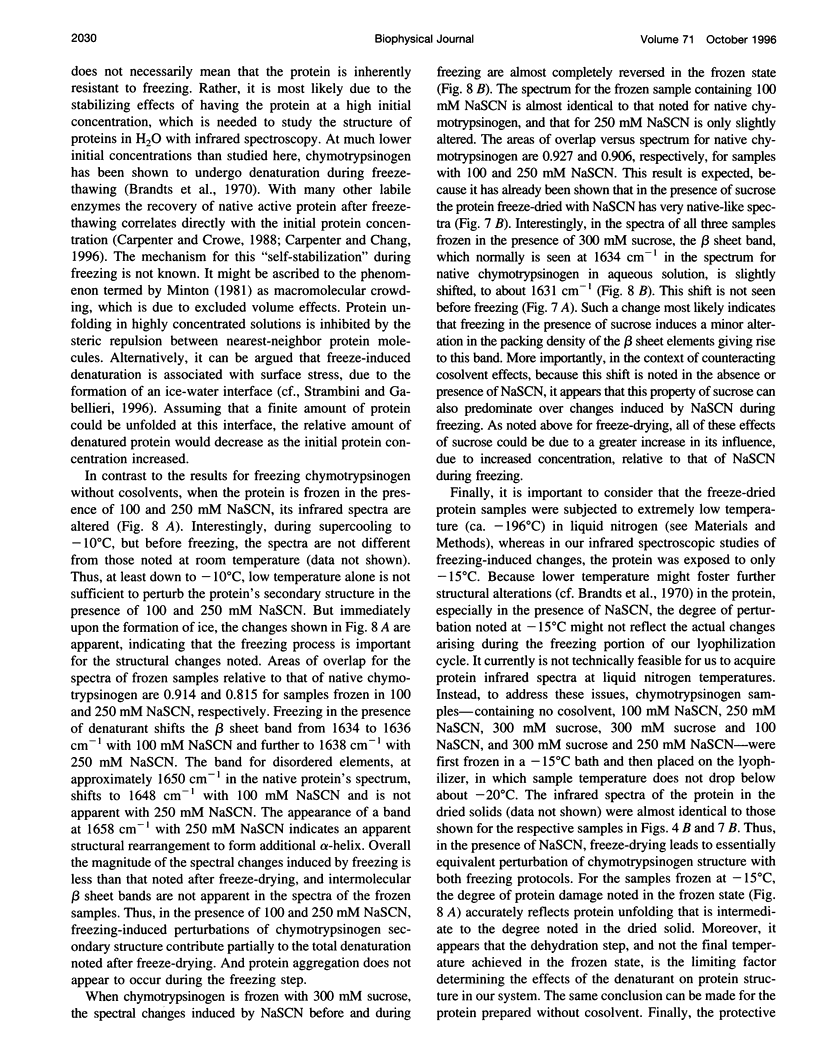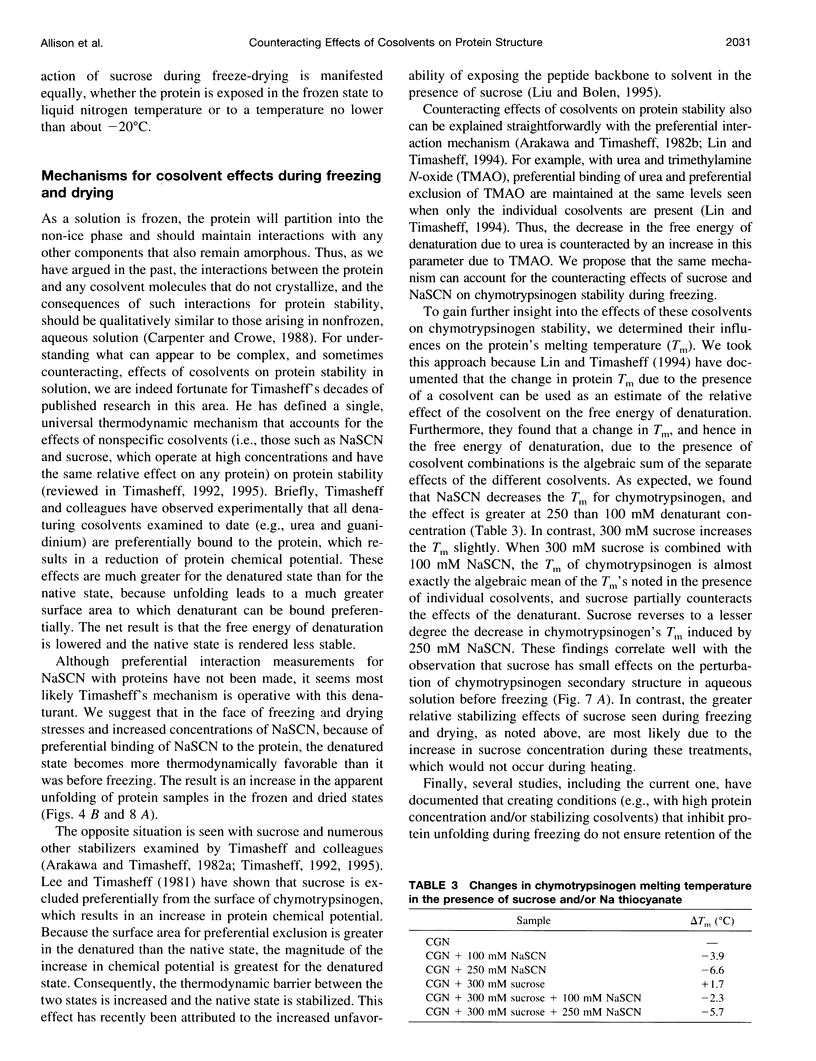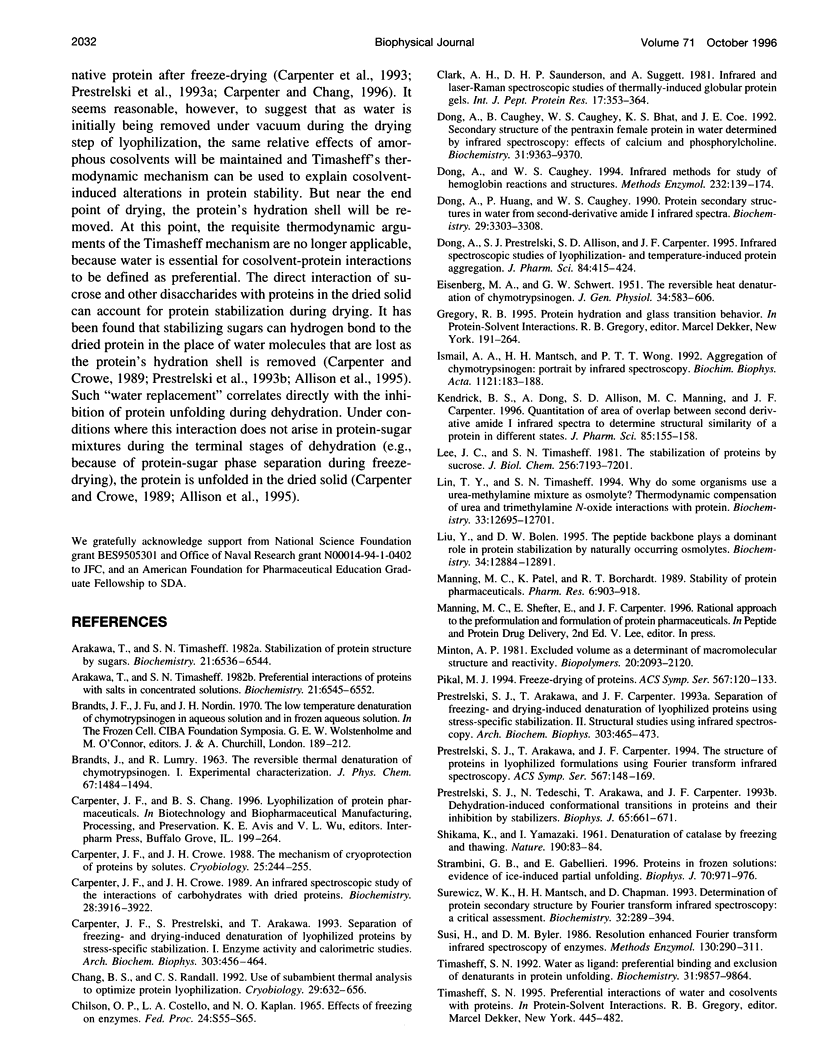Abstract
Studies of numerous proteins with infrared spectroscopy have documented that unfolding is a general response of unprotected proteins to freeze-drying. Some proteins that are unfolded in the dried solid aggregate during rehydration, whereas others refold. It has been proposed for the latter case that aggregation is avoided because refolding kinetically outcompetes intermolecular interactions. In contrast, with proteins that normally aggregate after rehydration, minimizing unfolding during freeze-drying with stabilizer has been shown to be needed to favor the recovery of native protein molecules after rehydration. The purpose of the current study was to examine first the opposite situation, in which a denaturant is used to foster additional unfolding in the protein population during freeze-drying. If the protein is not intrinsically resistant to aggregation under the study conditions (e.g., because of intermolecular charge repulsion) and the denaturant does not disrupt intermolecular interactions during rehydration, this treatment should favor aggregation upon rehydration. With infrared spectroscopy we found that at concentrations of the denaturant Na thiocyanate (NaSCN) that only slightly perturbed chymotrypsinogen secondary structure in solution before freeze-drying, there was a large increase in protein unfolding in the dried solid and in protein aggregation measured after rehydration. Bands assigned to intermolecular beta sheet were present in the spectra of samples dried with NaSCN, indicating that aggregation could also arise in the dried solid. By examining the protein structure in the frozen state, we determined that in the absence of NaSCN the protein remains native. NaSCN caused structural perturbations during freezing, without the formation of intermolecular beta sheet, that were intermediate to structural changes noted after freeze-drying. In contrast, samples treated in the presence of NaSCN and sucrose had native-like spectra in the frozen and dried states, and much reduced aggregation after rehydration. These results indicate that during freezing and drying the sugar can counteract and mostly reverse the structural perturbations induced by NaSCN before and during these treatments.
Full text
PDF










Selected References
These references are in PubMed. This may not be the complete list of references from this article.
- Arakawa T., Timasheff S. N. Preferential interactions of proteins with salts in concentrated solutions. Biochemistry. 1982 Dec 7;21(25):6545–6552. doi: 10.1021/bi00268a034. [DOI] [PubMed] [Google Scholar]
- Arakawa T., Timasheff S. N. Stabilization of protein structure by sugars. Biochemistry. 1982 Dec 7;21(25):6536–6544. doi: 10.1021/bi00268a033. [DOI] [PubMed] [Google Scholar]
- CHILSON O. P., COSTELLO L. A., KAPLAN N. O. EFFECTS OF FREEZING ON ENZYMES. Fed Proc. 1965 Mar-Apr;24:S55–S65. [PubMed] [Google Scholar]
- Carpenter J. F., Crowe J. H. An infrared spectroscopic study of the interactions of carbohydrates with dried proteins. Biochemistry. 1989 May 2;28(9):3916–3922. doi: 10.1021/bi00435a044. [DOI] [PubMed] [Google Scholar]
- Carpenter J. F., Crowe J. H. The mechanism of cryoprotection of proteins by solutes. Cryobiology. 1988 Jun;25(3):244–255. doi: 10.1016/0011-2240(88)90032-6. [DOI] [PubMed] [Google Scholar]
- Carpenter J. F., Prestrelski S. J., Arakawa T. Separation of freezing- and drying-induced denaturation of lyophilized proteins using stress-specific stabilization. I. Enzyme activity and calorimetric studies. Arch Biochem Biophys. 1993 Jun;303(2):456–464. doi: 10.1006/abbi.1993.1309. [DOI] [PubMed] [Google Scholar]
- Clark A. H., Saunderson D. H., Suggett A. Infrared and laser-Raman spectroscopic studies of thermally-induced globular protein gels. Int J Pept Protein Res. 1981 Mar;17(3):353–364. doi: 10.1111/j.1399-3011.1981.tb02002.x. [DOI] [PubMed] [Google Scholar]
- Dong A., Caughey B., Caughey W. S., Bhat K. S., Coe J. E. Secondary structure of the pentraxin female protein in water determined by infrared spectroscopy: effects of calcium and phosphorylcholine. Biochemistry. 1992 Oct 6;31(39):9364–9370. doi: 10.1021/bi00154a006. [DOI] [PubMed] [Google Scholar]
- Dong A., Caughey W. S. Infrared methods for study of hemoglobin reactions and structures. Methods Enzymol. 1994;232:139–175. doi: 10.1016/0076-6879(94)32047-0. [DOI] [PubMed] [Google Scholar]
- Dong A., Huang P., Caughey W. S. Protein secondary structures in water from second-derivative amide I infrared spectra. Biochemistry. 1990 Apr 3;29(13):3303–3308. doi: 10.1021/bi00465a022. [DOI] [PubMed] [Google Scholar]
- Dong A., Prestrelski S. J., Allison S. D., Carpenter J. F. Infrared spectroscopic studies of lyophilization- and temperature-induced protein aggregation. J Pharm Sci. 1995 Apr;84(4):415–424. doi: 10.1002/jps.2600840407. [DOI] [PubMed] [Google Scholar]
- EISENBERG M. A., SCHWERT G. W. The reversible heat denaturation of chymotrypsinogen. J Gen Physiol. 1951 May;34(5):583–606. doi: 10.1085/jgp.34.5.583. [DOI] [PMC free article] [PubMed] [Google Scholar]
- Ismail A. A., Mantsch H. H., Wong P. T. Aggregation of chymotrypsinogen: portrait by infrared spectroscopy. Biochim Biophys Acta. 1992 May 22;1121(1-2):183–188. doi: 10.1016/0167-4838(92)90353-f. [DOI] [PubMed] [Google Scholar]
- Kendrick B. S., Dong A., Allison S. D., Manning M. C., Carpenter J. F. Quantitation of the area of overlap between second-derivative amide I infrared spectra to determine the structural similarity of a protein in different states. J Pharm Sci. 1996 Feb;85(2):155–158. doi: 10.1021/js950332f. [DOI] [PubMed] [Google Scholar]
- Lee J. C., Timasheff S. N. The stabilization of proteins by sucrose. J Biol Chem. 1981 Jul 25;256(14):7193–7201. [PubMed] [Google Scholar]
- Lin T. Y., Timasheff S. N. Why do some organisms use a urea-methylamine mixture as osmolyte? Thermodynamic compensation of urea and trimethylamine N-oxide interactions with protein. Biochemistry. 1994 Oct 25;33(42):12695–12701. doi: 10.1021/bi00208a021. [DOI] [PubMed] [Google Scholar]
- Liu Y., Bolen D. W. The peptide backbone plays a dominant role in protein stabilization by naturally occurring osmolytes. Biochemistry. 1995 Oct 3;34(39):12884–12891. doi: 10.1021/bi00039a051. [DOI] [PubMed] [Google Scholar]
- Manning M. C., Patel K., Borchardt R. T. Stability of protein pharmaceuticals. Pharm Res. 1989 Nov;6(11):903–918. doi: 10.1023/a:1015929109894. [DOI] [PubMed] [Google Scholar]
- Prestrelski S. J., Arakawa T., Carpenter J. F. Separation of freezing- and drying-induced denaturation of lyophilized proteins using stress-specific stabilization. II. Structural studies using infrared spectroscopy. Arch Biochem Biophys. 1993 Jun;303(2):465–473. doi: 10.1006/abbi.1993.1310. [DOI] [PubMed] [Google Scholar]
- Prestrelski S. J., Tedeschi N., Arakawa T., Carpenter J. F. Dehydration-induced conformational transitions in proteins and their inhibition by stabilizers. Biophys J. 1993 Aug;65(2):661–671. doi: 10.1016/S0006-3495(93)81120-2. [DOI] [PMC free article] [PubMed] [Google Scholar]
- Strambini G. B., Gabellieri E. Proteins in frozen solutions: evidence of ice-induced partial unfolding. Biophys J. 1996 Feb;70(2):971–976. doi: 10.1016/S0006-3495(96)79640-6. [DOI] [PMC free article] [PubMed] [Google Scholar]
- Surewicz W. K., Mantsch H. H., Chapman D. Determination of protein secondary structure by Fourier transform infrared spectroscopy: a critical assessment. Biochemistry. 1993 Jan 19;32(2):389–394. doi: 10.1021/bi00053a001. [DOI] [PubMed] [Google Scholar]
- Susi H., Byler D. M. Resolution-enhanced Fourier transform infrared spectroscopy of enzymes. Methods Enzymol. 1986;130:290–311. doi: 10.1016/0076-6879(86)30015-6. [DOI] [PubMed] [Google Scholar]
- Timasheff S. N. Water as ligand: preferential binding and exclusion of denaturants in protein unfolding. Biochemistry. 1992 Oct 20;31(41):9857–9864. doi: 10.1021/bi00156a001. [DOI] [PubMed] [Google Scholar]


